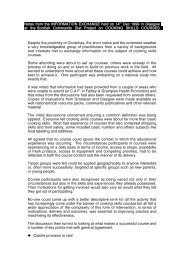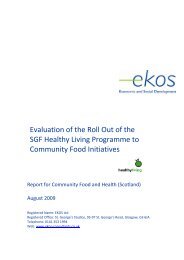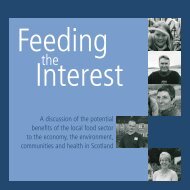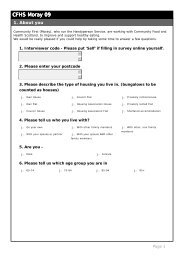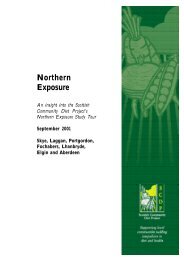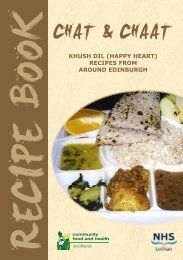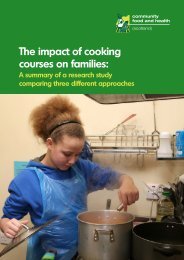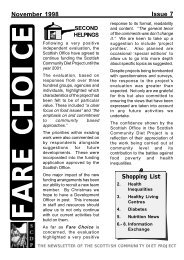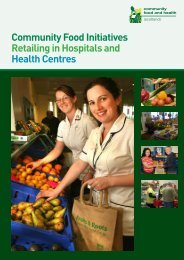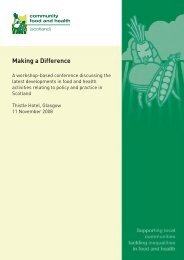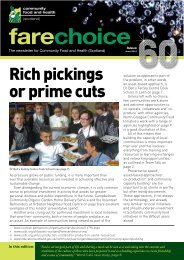North Glasgow Youth Food Guidelines and Healthy Eating Toolkit
North Glasgow Youth Food Guidelines and Healthy Eating Toolkit
North Glasgow Youth Food Guidelines and Healthy Eating Toolkit
Create successful ePaper yourself
Turn your PDF publications into a flip-book with our unique Google optimized e-Paper software.
5 - 6 <strong>North</strong> <strong>Glasgow</strong> <strong>Youth</strong> <strong>Food</strong> <strong>Guidelines</strong> <strong>and</strong> <strong>Healthy</strong> <strong>Eating</strong> <strong>Toolkit</strong><br />
Previous page:<br />
The eatwell plate shows how much of what you eat should<br />
come from each food group. This includes everything you eat<br />
during the day, including snacks. So, try to eat:<br />
• Plenty of fruit <strong>and</strong> vegetables<br />
• Plenty of bread, rice, potatoes, pasta <strong>and</strong> other starchy foods<br />
- choose wholegrain varieties whenever you can<br />
• Some milk <strong>and</strong> dairy foods<br />
• Some meat, fish, eggs, beans <strong>and</strong> other non-dairy sources<br />
of protein<br />
• Just a small amount of foods <strong>and</strong> drinks high in fat <strong>and</strong>/or sugar<br />
Why do we need to eat?<br />
Our food provides us with the energy <strong>and</strong> nutrients<br />
we need to live <strong>and</strong> grow. We need to eat a variety of<br />
foods to get all the nutrients we need, such as vitamins,<br />
minerals <strong>and</strong> protein.<br />
What should we eat?<br />
On the ‘Eatwell’ plate there are no ‘good’ or ‘bad’<br />
foods, but types of foods that we should try to eat<br />
more or less of to achieve a balanced diet. We also<br />
need to make sure we drink enough fluids, such as<br />
water, juice or tea: at least 8 glasses a day.<br />
We should try to eat lots of fruit <strong>and</strong> vegetables;<br />
these are packed with vitamins <strong>and</strong> fibre to help<br />
keep our digestion healthy, at least 5 portions a day.<br />
A portion is roughly the size of what you can hold<br />
in your h<strong>and</strong>, e.g. an apple, half a melon, or 2 big<br />
spoons of cooked vegetables.<br />
We should make sure foods such as bread, rice, pasta<br />
<strong>and</strong> cereals are included in each meal as they provide<br />
most of our body’s energy, fill us up <strong>and</strong> also contain<br />
a lot of fibre: good for our bowels <strong>and</strong> our heart.<br />
Try some wholegrain varieties too as they contain<br />
more fibre, vitamins <strong>and</strong> minerals, <strong>and</strong> give you<br />
longer lasting energy too.<br />
Dairy food, that is milk, cheese <strong>and</strong> yoghurt, is full of<br />
calcium which is very good for our teeth <strong>and</strong> bones.<br />
It can be quite high in fat too though so we should<br />
eat some foods from this group a day, but not lots.<br />
What is HIGH<br />
per 100g?<br />
Meat, fish <strong>and</strong> eggs provide us with protein which is<br />
essential for growth <strong>and</strong> repair of our bodies, <strong>and</strong> also<br />
the mineral iron which helps us to transport oxygen<br />
round our bodies. Vegetarians <strong>and</strong> Vegans can get<br />
protein from nuts <strong>and</strong> pulses, like beans or chickpeas.<br />
We should eat some of these foods every day, but not<br />
too much as they often contain high levels of saturated<br />
fat which can lead to heart disease.<br />
We all love fatty <strong>and</strong> sugary foods, like crisps, fizzy juice,<br />
pastries <strong>and</strong> chocolate, but we should try to limit our<br />
intake of these as they can lead to obesity, tooth decay<br />
<strong>and</strong> contain hardly any of the nutrients our bodies need.<br />
If we do eat these we should try <strong>and</strong> eat these at<br />
mealtimes to limit the damage to our teeth.<br />
Have a look at the further information section to find<br />
out more about healthy eating.<br />
How do we know what is a healthy choice?<br />
The <strong>Food</strong> St<strong>and</strong>ards Agency has developed the ‘traffic<br />
light’ labelling scheme for identifying at a glance which<br />
foods are a healthier choice by making them red,<br />
amber or green for fat, saturated fat, sugar <strong>and</strong> salt.<br />
What do the colours mean?<br />
• Red means HIGH - Indicating that the food is high<br />
in fat, sugars or salt.<br />
• Amber means MEDIUM - Indicating that it is an<br />
ok choice.<br />
• Green means LOW - This makes it a healthier choice.<br />
What is MEDIUM<br />
per 100g?<br />
What is MEDIUM<br />
per 100g?<br />
School Aged Children (5-12)<br />
When children leave home or nursery to attend school,<br />
their opportunities to learn <strong>and</strong> experience food in a<br />
number of environments <strong>and</strong> eating situations grows.<br />
For example they now have the opportunity to choose<br />
their own food from school meal menus, tuck shop etc.<br />
They also have more opportunity to share foods with<br />
friends, <strong>and</strong> to learn about food through lessons <strong>and</strong><br />
experiencing new foods.<br />
Despite this change in environment <strong>and</strong> choice,<br />
children of this age continue to need a varied diet<br />
to help provide the continued supply of energy <strong>and</strong><br />
nutrients needed for their growth. While children in<br />
this age group still have high energy requirements<br />
in relation to their size, good eating habits start<br />
in childhood, <strong>and</strong> children of this age should be<br />
encouraged to make food choices that will<br />
help lead to healthy eating habits later in life.<br />
Adolescence <strong>and</strong> Young Adults (12-19)<br />
Adolescence <strong>and</strong> the first steps into adulthood are<br />
not only a time of physical <strong>and</strong> emotional change<br />
but of the continued development of diet <strong>and</strong> other<br />
health related behaviors. Young people choose foods<br />
for many reasons other than their nutritional content<br />
including peer pressure to eat certain foods, weight<br />
control <strong>and</strong> slimming (whether justified or not) change<br />
in beliefs such as wishing to follow a vegetarian diet<br />
or simply just out of convenience.<br />
Growth <strong>and</strong> development happens very quickly in<br />
adolescence <strong>and</strong> even though the dem<strong>and</strong>s for energy<br />
<strong>and</strong> nutrients such as iron, calcium, vitamin C <strong>and</strong><br />
zinc differs between boys <strong>and</strong> girls, the need for<br />
these is high. It is therefore important that a varied<br />
diet is encouraged especially one that promotes<br />
iron <strong>and</strong> calcium rich foods. Poor nutrition during<br />
adolescence can lead to diseases like osteoporosis<br />
in later life <strong>and</strong> may lead to stunted growth <strong>and</strong> the<br />
delay of puberty if severe.<br />
Special Dietary Requirements<br />
Children <strong>and</strong> young people may have individual dietary<br />
requirements for example related to religious reasons<br />
(e.g. halal <strong>and</strong> kosher) or food allergy/intolerances or<br />
medical conditions such as diabetes <strong>and</strong> children who<br />
are overweight. Individual dietary requirements should<br />
always be considered.<br />
Fat<br />
Over 20g<br />
Between 3g <strong>and</strong> 20g<br />
Under 3g<br />
Saturated Fat<br />
Over 5g<br />
Between 1.5g <strong>and</strong> 5g<br />
Under 1.5g<br />
Sugars<br />
Over 15g<br />
Between 5g <strong>and</strong> 15g<br />
Under 5g<br />
Salt<br />
Over 1.5g<br />
Between 0.3g <strong>and</strong> 1.5g<br />
Under 0.3g



